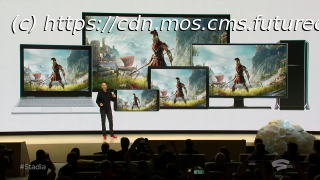A world where you can open a Chrome tab to play Destiny 2 is finally here.
Imagine a world in which you don’t need expensive gaming equipment to play the next big release title. A world in which all you ever have to do to start gaming is open up your browser, select a game and start playing – no lengthy download required. This could soon become a reality if Google’s cloud gaming service, Stadia, delivers on its promises. Bringing you great gaming from Chrome tab to 4K, 60fps game, in five seconds. No installation required.
The service, which was announced at this year’s Game Developers Conference in San Francisco, got a proper unveiling ahead of E3 2019. In a 15-minute presentation starring Google Stadia boss Phil Harrison, we learned just how much the service will set us back ($9.99 per month for unlimited games) and just how good of a connection we’ll need (35mbps for full 4K HDR/60fps).
At launch, Google has promised that Stadia will support desktops, laptops, tablets and smartphones – but just the Pixel series to start – without the need for a hardware box, instead running on Google’s own data center.
So far, Google has promised that Google Stadia’s cloud computing power is the equivalent of a console running at 10.7 GPU terraflops, which is more than the PS4 Pro and Xbox One X combined. This could be a total game-changer.
The best bit about Stadia is that as long as you’ve got a stable and fast internet connection, and you’re using a recent version of the Google Chrome browser, you’ve got everything you need to get up and running.
Playing a videogame on Stadia is as simple as opening a new tab up in Chrome and going to the service’s Stadia.com homepage, or even jumping from a YouTube video link about the game.
To get started, Google will prompt you to run a connection test that checks your internet bandwidth, the latency between your computer and the servers, and any data loss. Google requires a streaming rate of 15Mbps, latency below 40ms, and data loss below 5%. With these requirements met, you’ll be ready to dive into a game.
The beta of Project Stream offered Assassin’s Creed Odyssey, which is nothing short of a demanding title. When you launched the game in your Chrome tab, it would go fullscreen, and run exactly as if it has been launched on a proper gaming computer (except without a deep graphics settings menu). You can play with a keyboard and mouse or connect a game controller and play that way.
All of your inputs on the computer get sent over to Google’s servers, processed in the game, and everything happening gets streamed right back to you. This is why that latency is so important, because you can’t have a good game experience if everything you do in the game shows up a second later.
The limits of Stadia are still being detailed, but Google has stated that Stadia will eventually be able to scale up to 8K / 120+fps frame rates, with 4K/ 60 fps play as the norm. That’s way above the standard bar for quality PC gaming.
What you’re effectively doing here is opening a new tab that pipes all your inputs to a high-end gaming PC that streams back the visuals and audio to your computer screen. This system is simpler than some others, which set you up with a virtual desktop that then remotely runs Steam, Origin, Battle.net, or what have you.
In the case of Assassin’s Creed Odyssey on Stadia, you are still required to log into a Ubisoft account to play, but beta testers aren’t required to own the game.
Stadia will also work well with Google Chromecast, which means you’ll be able to stream its games straight to any TV using Google’s streaming dongle, not to mention phones and computers.
You’ll be able to use keyboard and mouse or a gamepad to play Stadia, and Google’s Stadia gamepad, a brand new piece of hardware, seems particularly smart. First off, the issue of latency – the gamepad itself connects directly to Google’s cloud, which take a few of the steps out the data transfer chain, reducing the lag between your inputs being registered by the game. It also has a dedicated Google Assistant button, which Google claims will be loaded up with information on the title you’re playing, offering tips when needed, or allowing you to access special in-game features from developers.
In addition, it’ll support cross-platform multiplayer – so long as the other major game players want to take part, of course.
It’s unclear at this point whether Google will require players to buy games and pay for the streaming service in separate transactions, or whether access to select games will be bundled into the service.
The final number hasn’t been released just yet, but so far, the numbers look promising.
Home
United States
USA — IT Stadia: everything you need to know about Google's game-streaming service






